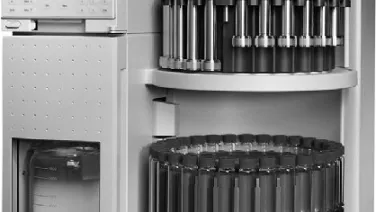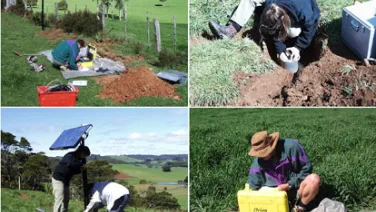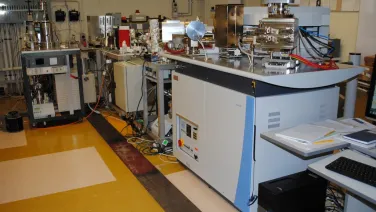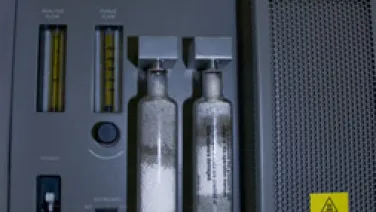
Facilities
The Research School of Earth Sciences hosts world-class equipment, which is maintained by experienced technical staff.

SPEctroscopy, Characterisation and Experimental Laboratory

The Accelerated Solvent Extractor at ANU, known as the DIONEX ASE 200, is an advanced system designed for efficient extraction of natural products, toxins, oils, and bitumens from various samples.

The ANU's accelerator mass spectrometer, introduced after a successful ARC LIEF grant in 2005, marks a new era in Carbon-14 Dating.

We research a wide range of topics relating to the use of carbon-14 in the environment. This includes using carbon-14 for dating purposes in, archaeology and forensics and as a carbon-14 as a tracer in the global carbon cycle, both in soils and in ocean circulation.

The ANU SHRIMP & SEM facility offers high-resolution ion microprobe analyses, allowing for precise measurements of stable isotopes, volatile elements, trace elements, and uranium-lead dating in solid materials.

The ANU GRACE software, developed in the Environmental Geodesy group at the Research School of Earth Sciences, is a suite of programs and scripts that processes the Level-1B data from the GRACE and GRACE Follow-On missions to estimate temporal variations in mass distribution on and within Earth.

At the Argon lab in RSES, we specialize in temperature-controlled step-heating diffusion experiments for precise Arrhenius analysis, allowing for the calculation of diffusion parameters and activation energies within crystal domains.

The National Argon Map (NAM) project, led by Dr. Marnie Forster at the Australian National University, aims to enhance the existing Geoscience Australia NAM with new Ar/Ar geochronology data. Supported by AuScope, the project collaborates with various institutions to fill gaps in isotopic mapping.

AusPass is an initiative supported with funding from AuScope and the Australian National University to provide F.A.I.R. access to passive seismic data collected in and around Australia.

ANSIR, a collaboration between ANU, Geoscience Australia, and the University of Adelaide, specializes in seismic research and equipment. Since 1997, it offers advanced seismic tools for domestic and international projects.

The Geophysical Fluid Dynamics laboratory is a purpose-built 400 sq. m laboratory for experimental fluid dynamics. This laboratory is designed for studies of fluid flow processes relevant to both solid earth geological processes and ocean-atmosphere dynamics.

The RSES's Cosmogenic Nuclide Laboratories focus on beryllium-10 and chlorine-36 analysis, featuring HEPA-filtered clean labs for sample preparation and safe acid handling equipment. Collaboration is possible for external projects, and also for cosmogenic isotope analysis and exposure dating on a quasi-commercial or commercial basis.

The Data Visualisation Laboratory at the Research School of Earth Sciences is equipped for high-performance data analysis and visualization. It features high-quality graphics capabilities and advanced software like ARCGis and Google Earth Pro for a wide range of analytical tasks.

The Ecochemistry laboratory is a dynamic, research based group that focuses on questions related to trace elements in natural waters.

The ESR spectrometer at ANU is one of the most versatile spectrometers. It has X-band and Q-band microwavebridges and measurements can be carried out between 3 and 700K.

The workshop provides a wide range of 'Design' and 'Instrumentation' services in support of research activities.

The Experimental Petrology Laboratory at ANU has been a leader in high-pressure experimental geochemistry for over 50 years. It features one of the world's largest collections of piston-cylinder apparatus, supporting a wide range of pressure and temperature conditions for research.

ANU research in rock physics employs novel equipment developed in house for laboratory studies of mechanical behaviour ranging widely from time-resolved slip on synthetic faults to seismic-frequency studies of wave speeds and attenuation.

The Gamma Spectroscopy facility at ANU is crucial for dating studies on paleoanthropological sites, offering non-destructive gamma ray analysis of large bone samples.

The Gas Chromatography-Mass Spectroscopy facility at ANU is equipped with advanced technology for detecting and analysing traces of apolar chemicals such as lipids, pigments, toxins, drugs and fossil hydrocarbons that occur in complex mixtures that may comprise millions of compounds.

Since 1998, RSES has used remote Global Positioning System (GPS) equipment in the southern Prince Charles Mountains, Antarctica, to measure the present-day glacial isostatic adjustment that may be occurring there.

RSES operates a Superconducting Gravimeter at Mt Stromlo Observatory, continuously monitoring small changes in gravity caused by tidal, environmental and seismic effects.

The High Pressure Liquid Chromatography facility at ANU features an Agilent 1100 Series capillary system and a Thermo LCQ™ DECA XP ion trap mass spectrometer. It's designed for analysing compounds like hopanepolyols and carotenoids that are sensitive to heat, polar, or large in molecular mass.

The ICP-MS Research Facility at ANU specializes in precise elemental and isotopic analysis using advanced Inductively Coupled Plasma Mass Spectrometry. It supports detailed trace element concentration studies and isotope ratio work for a wide range of elements, offering specific instruments for comprehensive analysis.

State of the art micropaleontological laboratory and microfossil collection from The Australian region.

RSES operates a Microscope laboratory containing transmitted light microscopes, a stereo microscope and diamond microdrill. This facility also contains Leica Cameras on two of the transmitted light microscopes, allowing users to take high resolution images to use in publication and presentations.

The Mt Stromlo station (CAN) just outside Canberra is operated on behalf of the French Geoscope Network and provides high quality broad-band seismic data to the international community.

The ANU Noble Gas Laboratory employs advanced techniques to extract and analyze noble gases from geological samples. Extraction methods include resistively-heated furnaces, vacuum crushers, and laser heating systems.

The Black Mountain Palaeomagnetic laboratory is equipped with a 2G superconducting rock magnetometer, a Quantum Design MPMS for magnetic mineral identification, a Princeton Measurements Corporation Vibrating Sample Magnetometer, and a suite of other instruments for palaeo- and rock magnetic measurements.

RSES has extensive facilities for mineral separation and rock preparation for geo-analysis and micro-analysis.

Explore ANU Earth Sciences' Spectroscopy Facility: a hub for advanced research with cutting-edge instruments for in-depth material analysis. Perfect for scientific exploration and discovery.

The Palaeoenvironment Stable Isotope Laboratory at RSES has a number of mass spectrometer facilities dedicated to particular types of analyses for δ13C and δ18O of carbonate samples, and δD, δ18O and δ17Oexcess of waters.

TerraWulf is a networked 'Beowulf' cluster of computers set up at RSES to provide convenient high end computing power for a range of demanding geoscience problems, particularly in the fields of thermochronology, seismology, geodesy, crustal and mantle dynamics, and landform evolution.

RSES has a number of thermal ionisation mass spectrometers available for high quality isotope ratio measurements.

Volatile analyser for water and carbon content determination, and quantitative analysis of volatile-rich minerals.

The Warramunga Seismic and Infrasound Research Station uses arrays of seismometers to detect tremors from nuclear testing on the ground, and infrasound sensors to detect atmospheric waves from nuclear testing in the air.

This facility provides mineral identification and quantification, structure refinements, and mineral analytical advice to RSES, the wider ANU community and external customers.

The ANU Research School of Earth Sciences operates a cutting-edge X-ray Fluorescence (XRF) scanning facility, capable of non-destructive elemental analysis from magnesium to uranium on a variety of samples including sediment cores and rocks.
